University Economics: Unemployment Analysis in Australia
VerifiedAdded on 2020/03/16
|16
|3705
|63
Essay
AI Summary
This economics essay provides a comprehensive analysis of unemployment in Australia, examining the current unemployment rate trends over the past five years, and highlighting key contributing factors such as economic growth uncertainties, higher production costs, low demand for younger workers, rapid population growth, minimum wage issues, and technological advancements like automation. The essay also identifies the three primary types of unemployment prevalent in Australia: structural, cyclical, and frictional, providing diagrams to illustrate each type. Furthermore, the essay discusses the Australian government's policies and initiatives aimed at addressing unemployment, including the Job Services Australia program and the Local Employment Coordinators, while also acknowledging the limitations and failures of these policies. The essay concludes by suggesting various potential solutions to mitigate unemployment in the Australian economy.
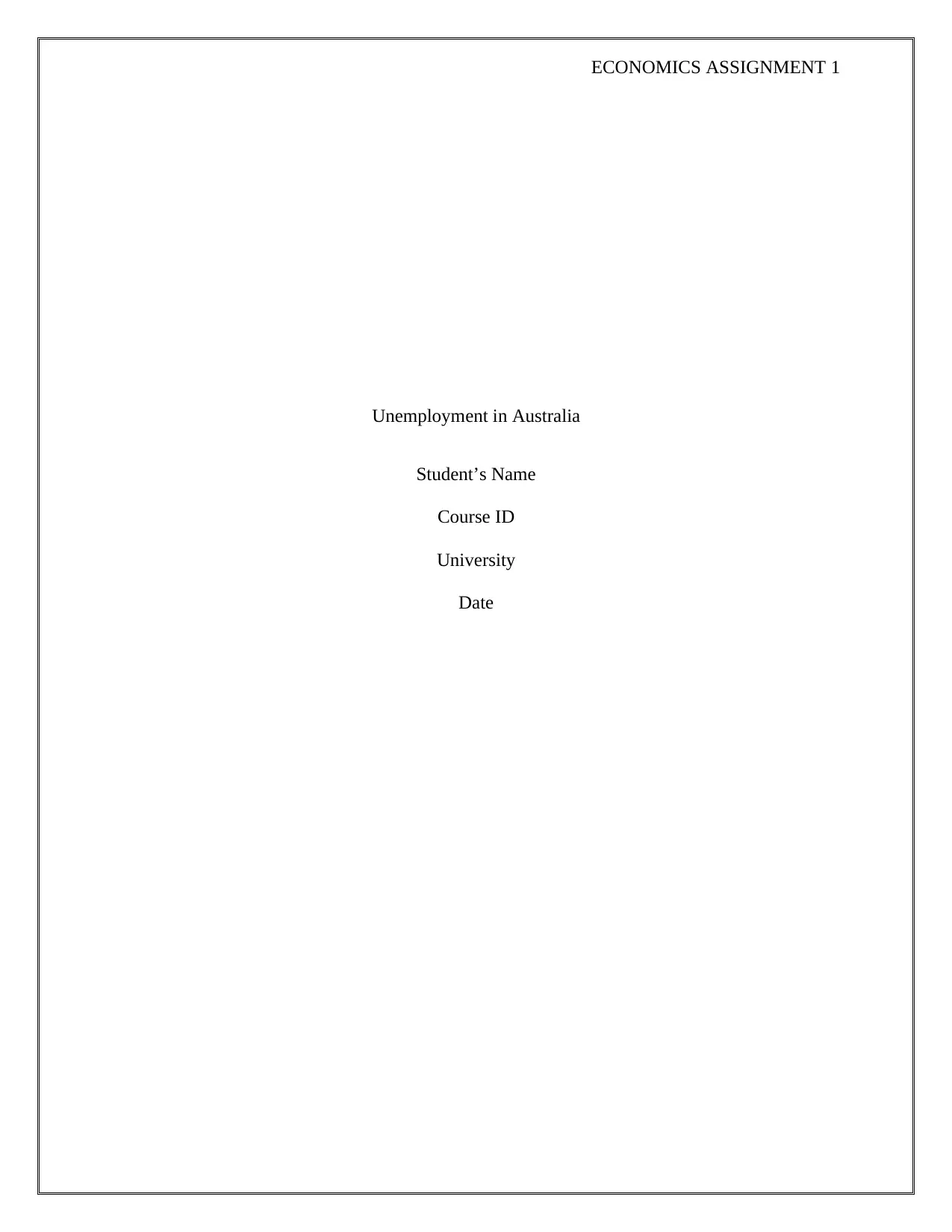
ECONOMICS ASSIGNMENT 1
Unemployment in Australia
Student’s Name
Course ID
University
Date
Unemployment in Australia
Student’s Name
Course ID
University
Date
Paraphrase This Document
Need a fresh take? Get an instant paraphrase of this document with our AI Paraphraser
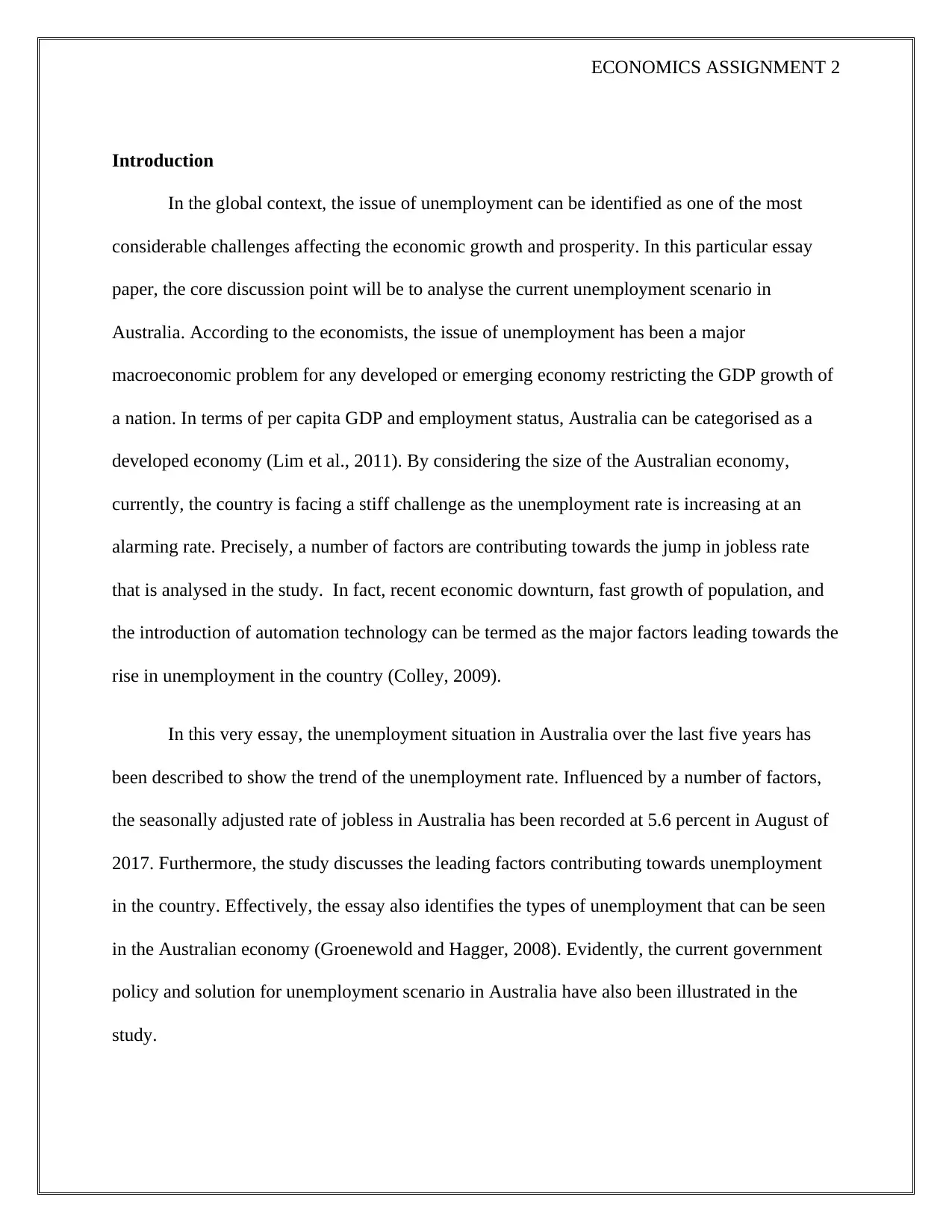
ECONOMICS ASSIGNMENT 2
Introduction
In the global context, the issue of unemployment can be identified as one of the most
considerable challenges affecting the economic growth and prosperity. In this particular essay
paper, the core discussion point will be to analyse the current unemployment scenario in
Australia. According to the economists, the issue of unemployment has been a major
macroeconomic problem for any developed or emerging economy restricting the GDP growth of
a nation. In terms of per capita GDP and employment status, Australia can be categorised as a
developed economy (Lim et al., 2011). By considering the size of the Australian economy,
currently, the country is facing a stiff challenge as the unemployment rate is increasing at an
alarming rate. Precisely, a number of factors are contributing towards the jump in jobless rate
that is analysed in the study. In fact, recent economic downturn, fast growth of population, and
the introduction of automation technology can be termed as the major factors leading towards the
rise in unemployment in the country (Colley, 2009).
In this very essay, the unemployment situation in Australia over the last five years has
been described to show the trend of the unemployment rate. Influenced by a number of factors,
the seasonally adjusted rate of jobless in Australia has been recorded at 5.6 percent in August of
2017. Furthermore, the study discusses the leading factors contributing towards unemployment
in the country. Effectively, the essay also identifies the types of unemployment that can be seen
in the Australian economy (Groenewold and Hagger, 2008). Evidently, the current government
policy and solution for unemployment scenario in Australia have also been illustrated in the
study.
Introduction
In the global context, the issue of unemployment can be identified as one of the most
considerable challenges affecting the economic growth and prosperity. In this particular essay
paper, the core discussion point will be to analyse the current unemployment scenario in
Australia. According to the economists, the issue of unemployment has been a major
macroeconomic problem for any developed or emerging economy restricting the GDP growth of
a nation. In terms of per capita GDP and employment status, Australia can be categorised as a
developed economy (Lim et al., 2011). By considering the size of the Australian economy,
currently, the country is facing a stiff challenge as the unemployment rate is increasing at an
alarming rate. Precisely, a number of factors are contributing towards the jump in jobless rate
that is analysed in the study. In fact, recent economic downturn, fast growth of population, and
the introduction of automation technology can be termed as the major factors leading towards the
rise in unemployment in the country (Colley, 2009).
In this very essay, the unemployment situation in Australia over the last five years has
been described to show the trend of the unemployment rate. Influenced by a number of factors,
the seasonally adjusted rate of jobless in Australia has been recorded at 5.6 percent in August of
2017. Furthermore, the study discusses the leading factors contributing towards unemployment
in the country. Effectively, the essay also identifies the types of unemployment that can be seen
in the Australian economy (Groenewold and Hagger, 2008). Evidently, the current government
policy and solution for unemployment scenario in Australia have also been illustrated in the
study.
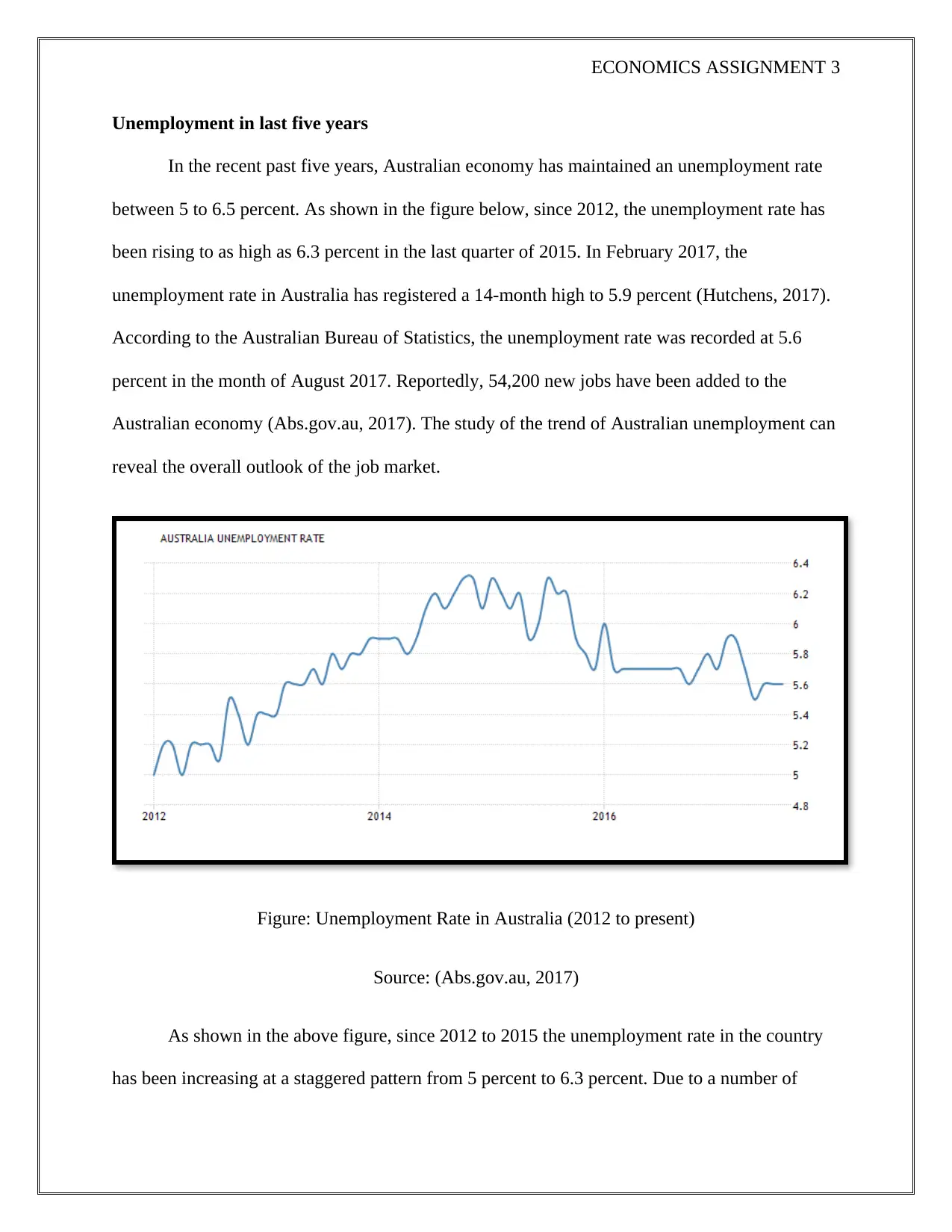
ECONOMICS ASSIGNMENT 3
Unemployment in last five years
In the recent past five years, Australian economy has maintained an unemployment rate
between 5 to 6.5 percent. As shown in the figure below, since 2012, the unemployment rate has
been rising to as high as 6.3 percent in the last quarter of 2015. In February 2017, the
unemployment rate in Australia has registered a 14-month high to 5.9 percent (Hutchens, 2017).
According to the Australian Bureau of Statistics, the unemployment rate was recorded at 5.6
percent in the month of August 2017. Reportedly, 54,200 new jobs have been added to the
Australian economy (Abs.gov.au, 2017). The study of the trend of Australian unemployment can
reveal the overall outlook of the job market.
Figure: Unemployment Rate in Australia (2012 to present)
Source: (Abs.gov.au, 2017)
As shown in the above figure, since 2012 to 2015 the unemployment rate in the country
has been increasing at a staggered pattern from 5 percent to 6.3 percent. Due to a number of
Unemployment in last five years
In the recent past five years, Australian economy has maintained an unemployment rate
between 5 to 6.5 percent. As shown in the figure below, since 2012, the unemployment rate has
been rising to as high as 6.3 percent in the last quarter of 2015. In February 2017, the
unemployment rate in Australia has registered a 14-month high to 5.9 percent (Hutchens, 2017).
According to the Australian Bureau of Statistics, the unemployment rate was recorded at 5.6
percent in the month of August 2017. Reportedly, 54,200 new jobs have been added to the
Australian economy (Abs.gov.au, 2017). The study of the trend of Australian unemployment can
reveal the overall outlook of the job market.
Figure: Unemployment Rate in Australia (2012 to present)
Source: (Abs.gov.au, 2017)
As shown in the above figure, since 2012 to 2015 the unemployment rate in the country
has been increasing at a staggered pattern from 5 percent to 6.3 percent. Due to a number of
⊘ This is a preview!⊘
Do you want full access?
Subscribe today to unlock all pages.

Trusted by 1+ million students worldwide
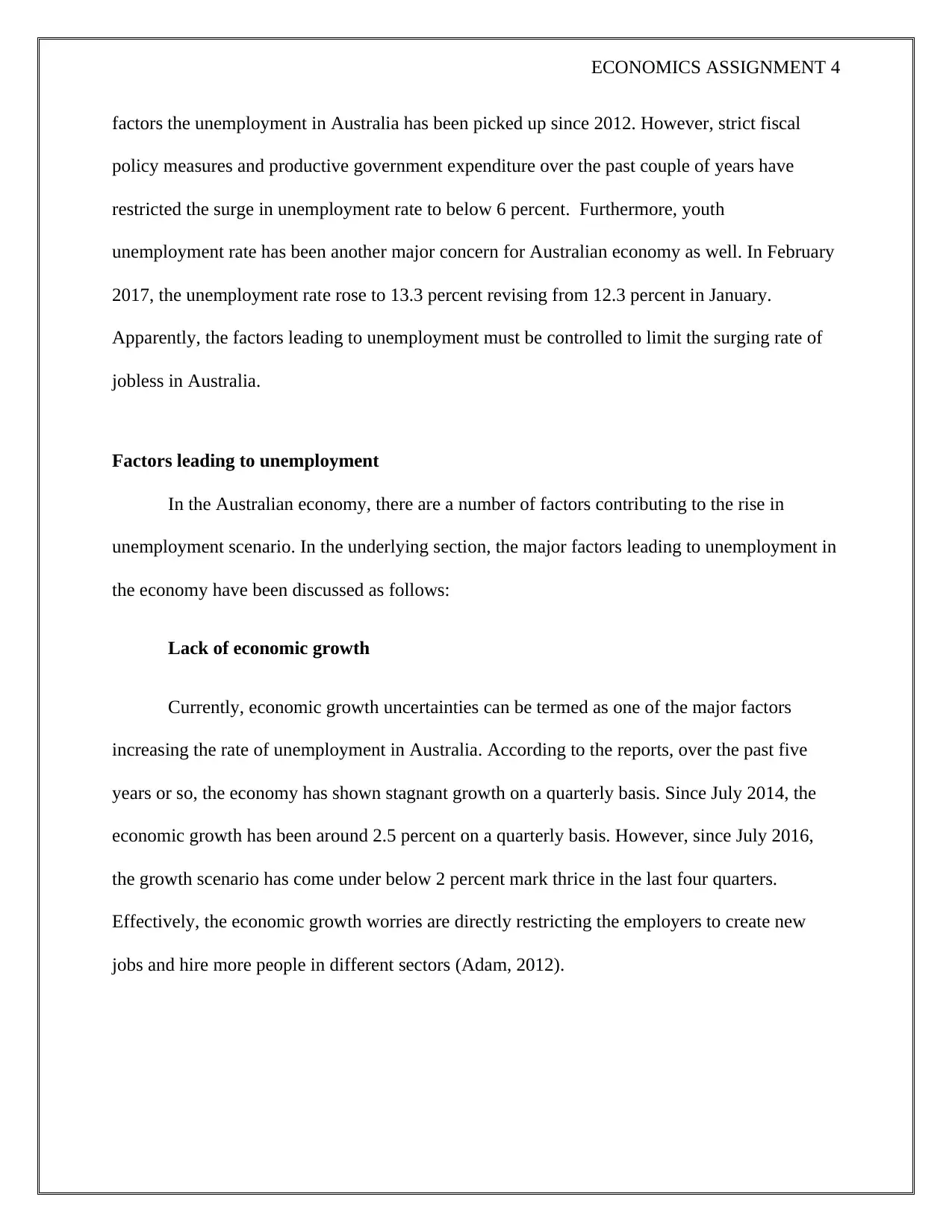
ECONOMICS ASSIGNMENT 4
factors the unemployment in Australia has been picked up since 2012. However, strict fiscal
policy measures and productive government expenditure over the past couple of years have
restricted the surge in unemployment rate to below 6 percent. Furthermore, youth
unemployment rate has been another major concern for Australian economy as well. In February
2017, the unemployment rate rose to 13.3 percent revising from 12.3 percent in January.
Apparently, the factors leading to unemployment must be controlled to limit the surging rate of
jobless in Australia.
Factors leading to unemployment
In the Australian economy, there are a number of factors contributing to the rise in
unemployment scenario. In the underlying section, the major factors leading to unemployment in
the economy have been discussed as follows:
Lack of economic growth
Currently, economic growth uncertainties can be termed as one of the major factors
increasing the rate of unemployment in Australia. According to the reports, over the past five
years or so, the economy has shown stagnant growth on a quarterly basis. Since July 2014, the
economic growth has been around 2.5 percent on a quarterly basis. However, since July 2016,
the growth scenario has come under below 2 percent mark thrice in the last four quarters.
Effectively, the economic growth worries are directly restricting the employers to create new
jobs and hire more people in different sectors (Adam, 2012).
factors the unemployment in Australia has been picked up since 2012. However, strict fiscal
policy measures and productive government expenditure over the past couple of years have
restricted the surge in unemployment rate to below 6 percent. Furthermore, youth
unemployment rate has been another major concern for Australian economy as well. In February
2017, the unemployment rate rose to 13.3 percent revising from 12.3 percent in January.
Apparently, the factors leading to unemployment must be controlled to limit the surging rate of
jobless in Australia.
Factors leading to unemployment
In the Australian economy, there are a number of factors contributing to the rise in
unemployment scenario. In the underlying section, the major factors leading to unemployment in
the economy have been discussed as follows:
Lack of economic growth
Currently, economic growth uncertainties can be termed as one of the major factors
increasing the rate of unemployment in Australia. According to the reports, over the past five
years or so, the economy has shown stagnant growth on a quarterly basis. Since July 2014, the
economic growth has been around 2.5 percent on a quarterly basis. However, since July 2016,
the growth scenario has come under below 2 percent mark thrice in the last four quarters.
Effectively, the economic growth worries are directly restricting the employers to create new
jobs and hire more people in different sectors (Adam, 2012).
Paraphrase This Document
Need a fresh take? Get an instant paraphrase of this document with our AI Paraphraser
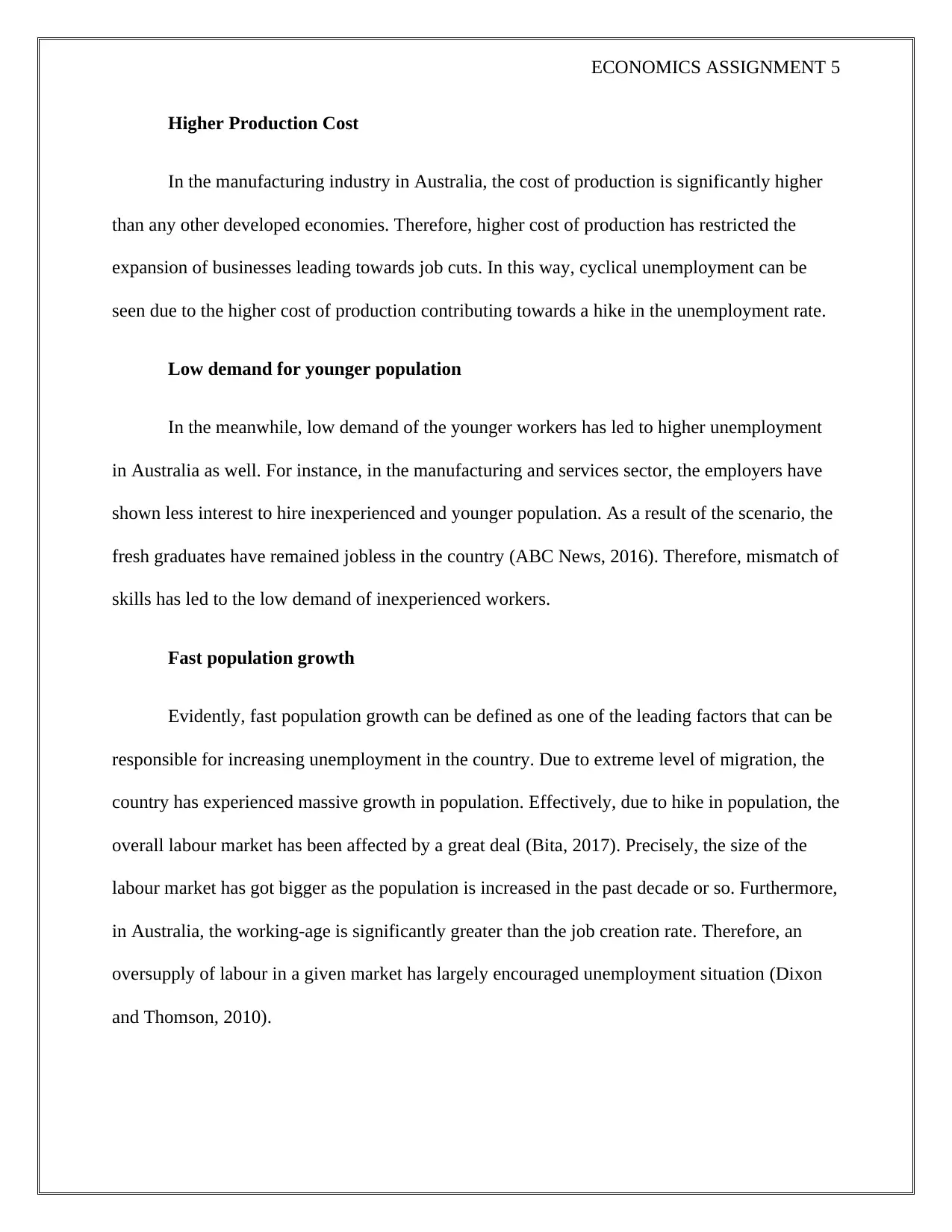
ECONOMICS ASSIGNMENT 5
Higher Production Cost
In the manufacturing industry in Australia, the cost of production is significantly higher
than any other developed economies. Therefore, higher cost of production has restricted the
expansion of businesses leading towards job cuts. In this way, cyclical unemployment can be
seen due to the higher cost of production contributing towards a hike in the unemployment rate.
Low demand for younger population
In the meanwhile, low demand of the younger workers has led to higher unemployment
in Australia as well. For instance, in the manufacturing and services sector, the employers have
shown less interest to hire inexperienced and younger population. As a result of the scenario, the
fresh graduates have remained jobless in the country (ABC News, 2016). Therefore, mismatch of
skills has led to the low demand of inexperienced workers.
Fast population growth
Evidently, fast population growth can be defined as one of the leading factors that can be
responsible for increasing unemployment in the country. Due to extreme level of migration, the
country has experienced massive growth in population. Effectively, due to hike in population, the
overall labour market has been affected by a great deal (Bita, 2017). Precisely, the size of the
labour market has got bigger as the population is increased in the past decade or so. Furthermore,
in Australia, the working-age is significantly greater than the job creation rate. Therefore, an
oversupply of labour in a given market has largely encouraged unemployment situation (Dixon
and Thomson, 2010).
Higher Production Cost
In the manufacturing industry in Australia, the cost of production is significantly higher
than any other developed economies. Therefore, higher cost of production has restricted the
expansion of businesses leading towards job cuts. In this way, cyclical unemployment can be
seen due to the higher cost of production contributing towards a hike in the unemployment rate.
Low demand for younger population
In the meanwhile, low demand of the younger workers has led to higher unemployment
in Australia as well. For instance, in the manufacturing and services sector, the employers have
shown less interest to hire inexperienced and younger population. As a result of the scenario, the
fresh graduates have remained jobless in the country (ABC News, 2016). Therefore, mismatch of
skills has led to the low demand of inexperienced workers.
Fast population growth
Evidently, fast population growth can be defined as one of the leading factors that can be
responsible for increasing unemployment in the country. Due to extreme level of migration, the
country has experienced massive growth in population. Effectively, due to hike in population, the
overall labour market has been affected by a great deal (Bita, 2017). Precisely, the size of the
labour market has got bigger as the population is increased in the past decade or so. Furthermore,
in Australia, the working-age is significantly greater than the job creation rate. Therefore, an
oversupply of labour in a given market has largely encouraged unemployment situation (Dixon
and Thomson, 2010).
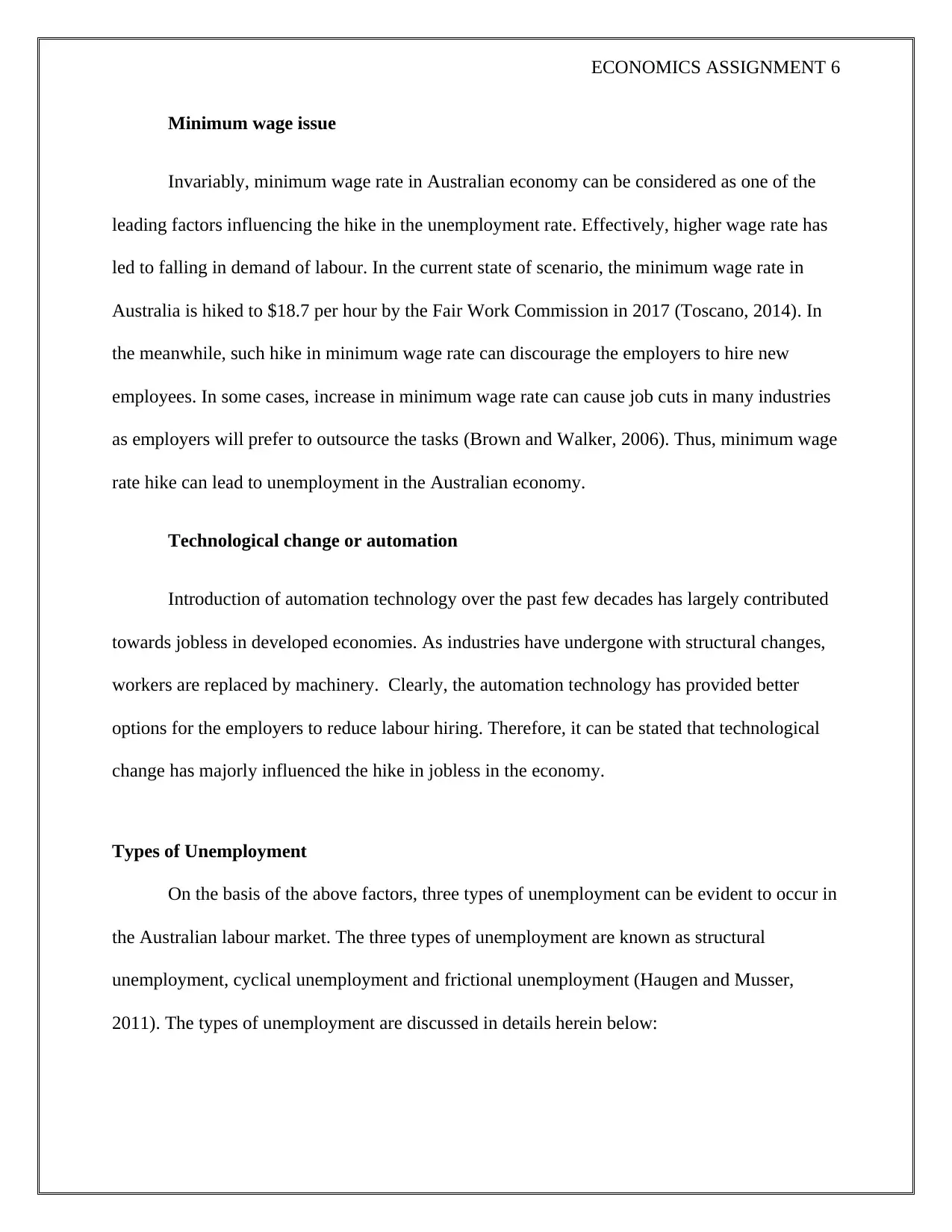
ECONOMICS ASSIGNMENT 6
Minimum wage issue
Invariably, minimum wage rate in Australian economy can be considered as one of the
leading factors influencing the hike in the unemployment rate. Effectively, higher wage rate has
led to falling in demand of labour. In the current state of scenario, the minimum wage rate in
Australia is hiked to $18.7 per hour by the Fair Work Commission in 2017 (Toscano, 2014). In
the meanwhile, such hike in minimum wage rate can discourage the employers to hire new
employees. In some cases, increase in minimum wage rate can cause job cuts in many industries
as employers will prefer to outsource the tasks (Brown and Walker, 2006). Thus, minimum wage
rate hike can lead to unemployment in the Australian economy.
Technological change or automation
Introduction of automation technology over the past few decades has largely contributed
towards jobless in developed economies. As industries have undergone with structural changes,
workers are replaced by machinery. Clearly, the automation technology has provided better
options for the employers to reduce labour hiring. Therefore, it can be stated that technological
change has majorly influenced the hike in jobless in the economy.
Types of Unemployment
On the basis of the above factors, three types of unemployment can be evident to occur in
the Australian labour market. The three types of unemployment are known as structural
unemployment, cyclical unemployment and frictional unemployment (Haugen and Musser,
2011). The types of unemployment are discussed in details herein below:
Minimum wage issue
Invariably, minimum wage rate in Australian economy can be considered as one of the
leading factors influencing the hike in the unemployment rate. Effectively, higher wage rate has
led to falling in demand of labour. In the current state of scenario, the minimum wage rate in
Australia is hiked to $18.7 per hour by the Fair Work Commission in 2017 (Toscano, 2014). In
the meanwhile, such hike in minimum wage rate can discourage the employers to hire new
employees. In some cases, increase in minimum wage rate can cause job cuts in many industries
as employers will prefer to outsource the tasks (Brown and Walker, 2006). Thus, minimum wage
rate hike can lead to unemployment in the Australian economy.
Technological change or automation
Introduction of automation technology over the past few decades has largely contributed
towards jobless in developed economies. As industries have undergone with structural changes,
workers are replaced by machinery. Clearly, the automation technology has provided better
options for the employers to reduce labour hiring. Therefore, it can be stated that technological
change has majorly influenced the hike in jobless in the economy.
Types of Unemployment
On the basis of the above factors, three types of unemployment can be evident to occur in
the Australian labour market. The three types of unemployment are known as structural
unemployment, cyclical unemployment and frictional unemployment (Haugen and Musser,
2011). The types of unemployment are discussed in details herein below:
⊘ This is a preview!⊘
Do you want full access?
Subscribe today to unlock all pages.

Trusted by 1+ million students worldwide
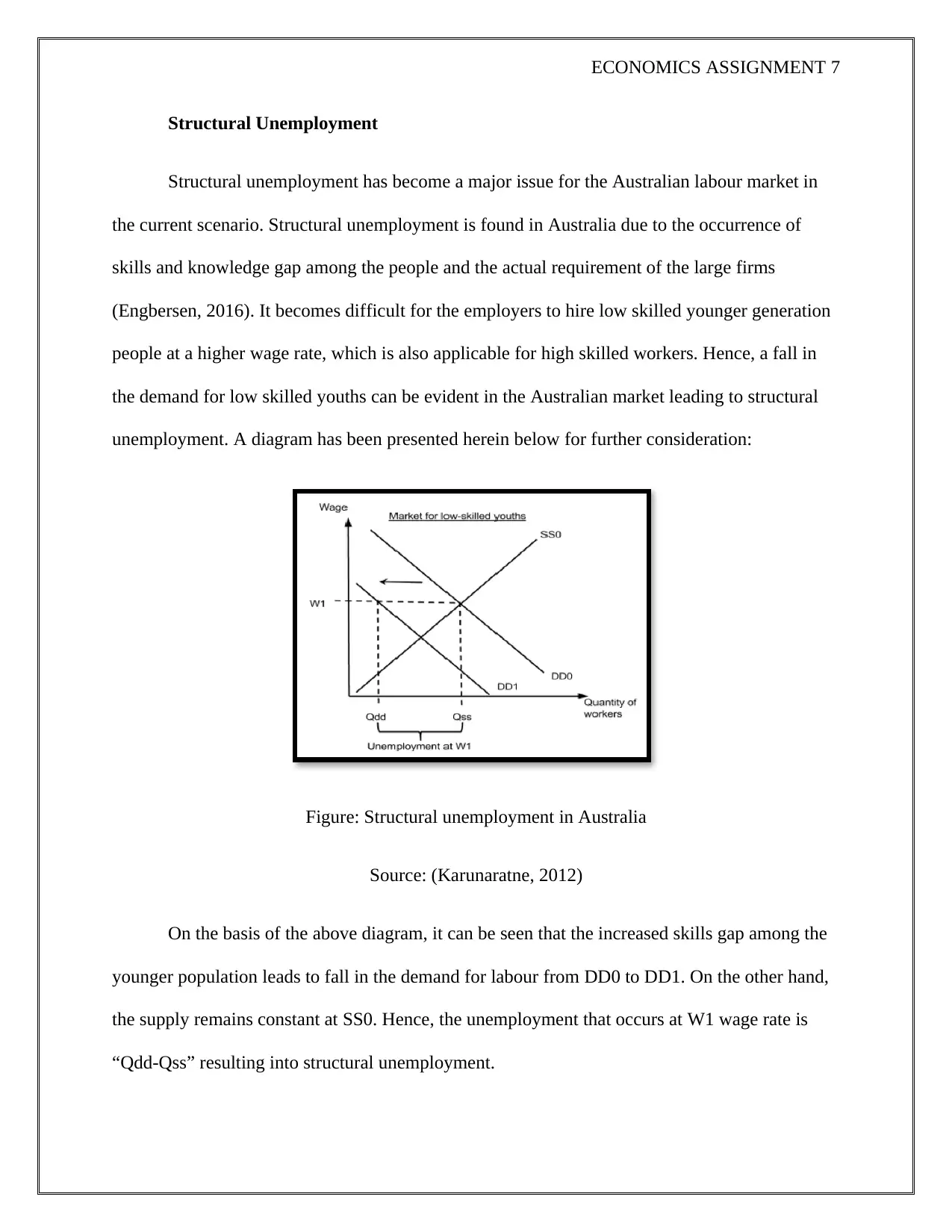
ECONOMICS ASSIGNMENT 7
Structural Unemployment
Structural unemployment has become a major issue for the Australian labour market in
the current scenario. Structural unemployment is found in Australia due to the occurrence of
skills and knowledge gap among the people and the actual requirement of the large firms
(Engbersen, 2016). It becomes difficult for the employers to hire low skilled younger generation
people at a higher wage rate, which is also applicable for high skilled workers. Hence, a fall in
the demand for low skilled youths can be evident in the Australian market leading to structural
unemployment. A diagram has been presented herein below for further consideration:
Figure: Structural unemployment in Australia
Source: (Karunaratne, 2012)
On the basis of the above diagram, it can be seen that the increased skills gap among the
younger population leads to fall in the demand for labour from DD0 to DD1. On the other hand,
the supply remains constant at SS0. Hence, the unemployment that occurs at W1 wage rate is
“Qdd-Qss” resulting into structural unemployment.
Structural Unemployment
Structural unemployment has become a major issue for the Australian labour market in
the current scenario. Structural unemployment is found in Australia due to the occurrence of
skills and knowledge gap among the people and the actual requirement of the large firms
(Engbersen, 2016). It becomes difficult for the employers to hire low skilled younger generation
people at a higher wage rate, which is also applicable for high skilled workers. Hence, a fall in
the demand for low skilled youths can be evident in the Australian market leading to structural
unemployment. A diagram has been presented herein below for further consideration:
Figure: Structural unemployment in Australia
Source: (Karunaratne, 2012)
On the basis of the above diagram, it can be seen that the increased skills gap among the
younger population leads to fall in the demand for labour from DD0 to DD1. On the other hand,
the supply remains constant at SS0. Hence, the unemployment that occurs at W1 wage rate is
“Qdd-Qss” resulting into structural unemployment.
Paraphrase This Document
Need a fresh take? Get an instant paraphrase of this document with our AI Paraphraser
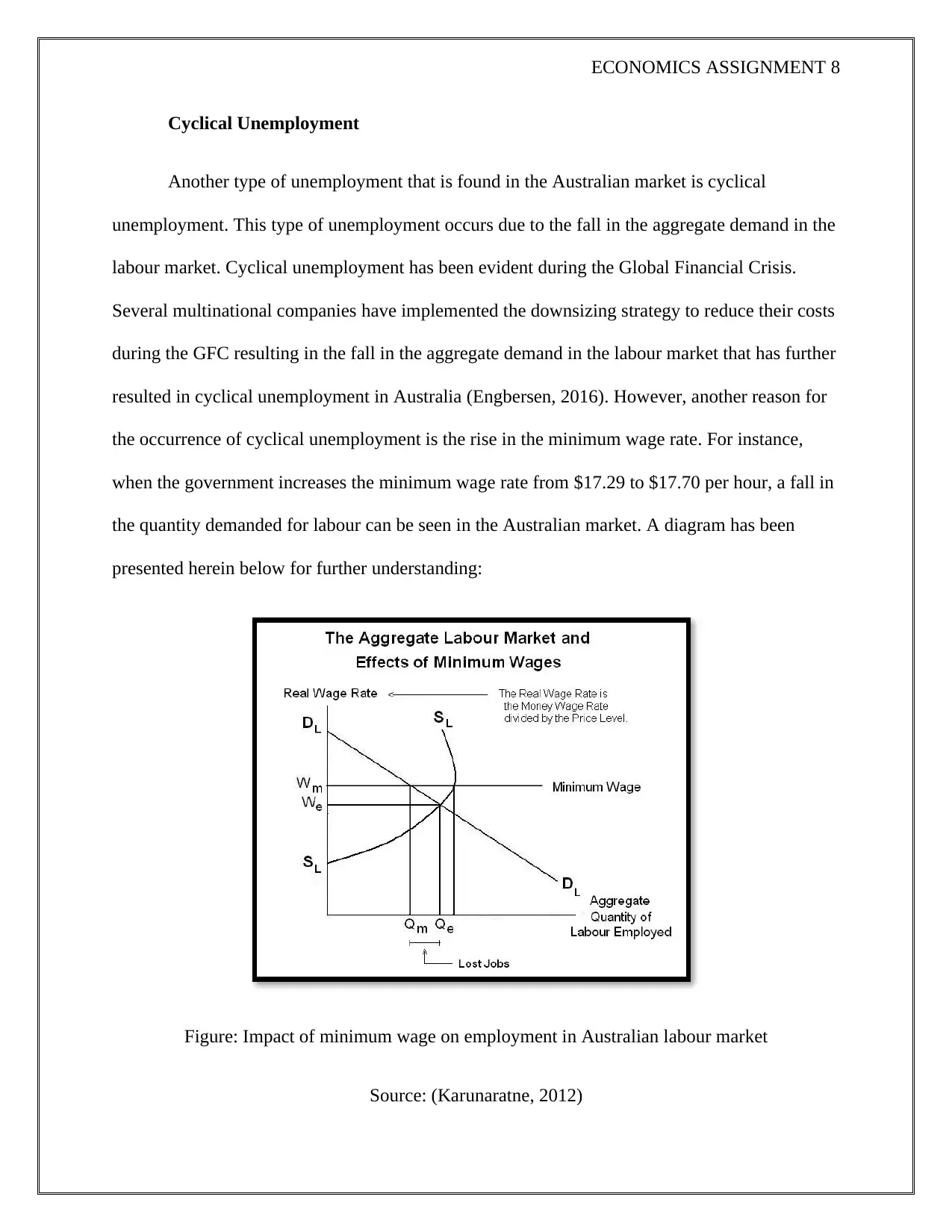
ECONOMICS ASSIGNMENT 8
Cyclical Unemployment
Another type of unemployment that is found in the Australian market is cyclical
unemployment. This type of unemployment occurs due to the fall in the aggregate demand in the
labour market. Cyclical unemployment has been evident during the Global Financial Crisis.
Several multinational companies have implemented the downsizing strategy to reduce their costs
during the GFC resulting in the fall in the aggregate demand in the labour market that has further
resulted in cyclical unemployment in Australia (Engbersen, 2016). However, another reason for
the occurrence of cyclical unemployment is the rise in the minimum wage rate. For instance,
when the government increases the minimum wage rate from $17.29 to $17.70 per hour, a fall in
the quantity demanded for labour can be seen in the Australian market. A diagram has been
presented herein below for further understanding:
Figure: Impact of minimum wage on employment in Australian labour market
Source: (Karunaratne, 2012)
Cyclical Unemployment
Another type of unemployment that is found in the Australian market is cyclical
unemployment. This type of unemployment occurs due to the fall in the aggregate demand in the
labour market. Cyclical unemployment has been evident during the Global Financial Crisis.
Several multinational companies have implemented the downsizing strategy to reduce their costs
during the GFC resulting in the fall in the aggregate demand in the labour market that has further
resulted in cyclical unemployment in Australia (Engbersen, 2016). However, another reason for
the occurrence of cyclical unemployment is the rise in the minimum wage rate. For instance,
when the government increases the minimum wage rate from $17.29 to $17.70 per hour, a fall in
the quantity demanded for labour can be seen in the Australian market. A diagram has been
presented herein below for further understanding:
Figure: Impact of minimum wage on employment in Australian labour market
Source: (Karunaratne, 2012)
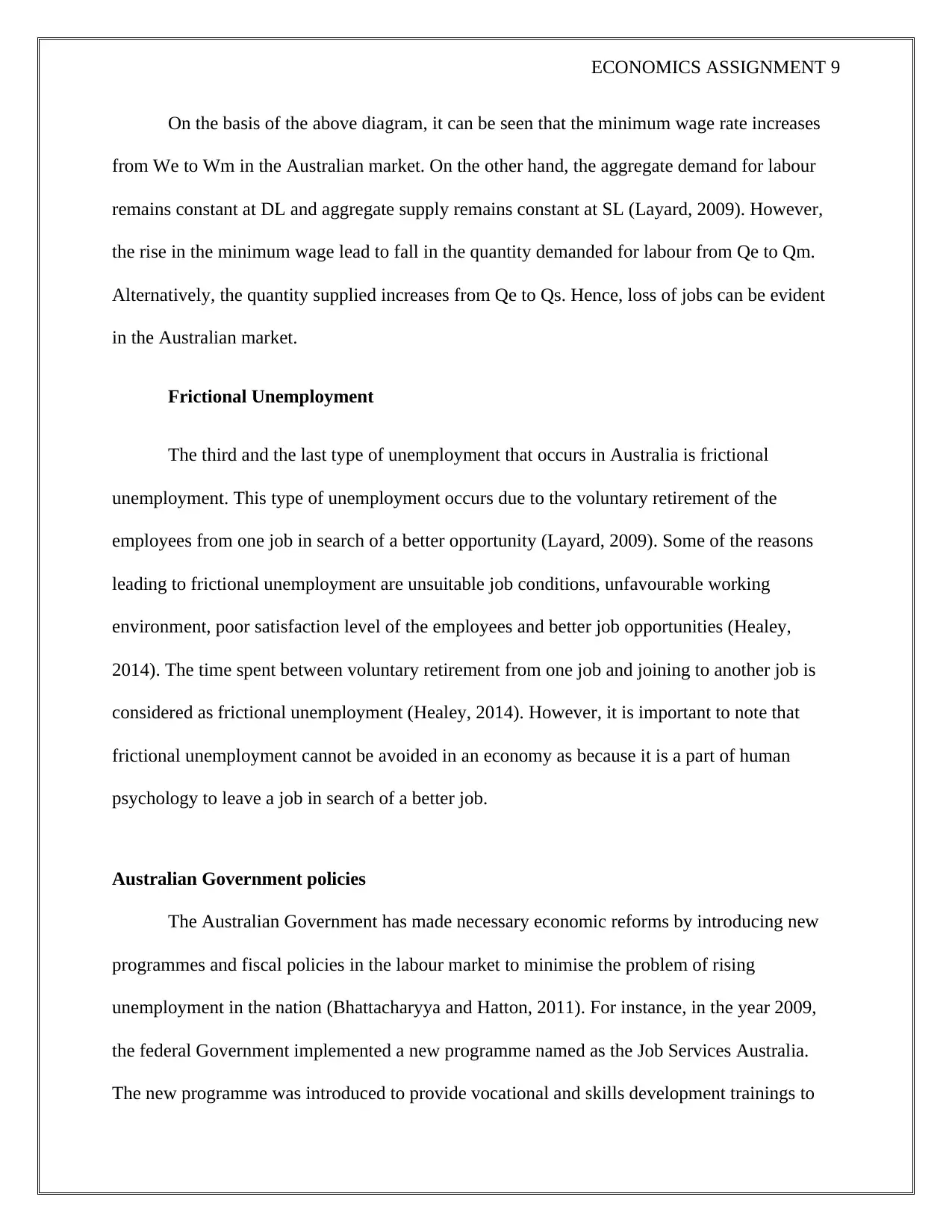
ECONOMICS ASSIGNMENT 9
On the basis of the above diagram, it can be seen that the minimum wage rate increases
from We to Wm in the Australian market. On the other hand, the aggregate demand for labour
remains constant at DL and aggregate supply remains constant at SL (Layard, 2009). However,
the rise in the minimum wage lead to fall in the quantity demanded for labour from Qe to Qm.
Alternatively, the quantity supplied increases from Qe to Qs. Hence, loss of jobs can be evident
in the Australian market.
Frictional Unemployment
The third and the last type of unemployment that occurs in Australia is frictional
unemployment. This type of unemployment occurs due to the voluntary retirement of the
employees from one job in search of a better opportunity (Layard, 2009). Some of the reasons
leading to frictional unemployment are unsuitable job conditions, unfavourable working
environment, poor satisfaction level of the employees and better job opportunities (Healey,
2014). The time spent between voluntary retirement from one job and joining to another job is
considered as frictional unemployment (Healey, 2014). However, it is important to note that
frictional unemployment cannot be avoided in an economy as because it is a part of human
psychology to leave a job in search of a better job.
Australian Government policies
The Australian Government has made necessary economic reforms by introducing new
programmes and fiscal policies in the labour market to minimise the problem of rising
unemployment in the nation (Bhattacharyya and Hatton, 2011). For instance, in the year 2009,
the federal Government implemented a new programme named as the Job Services Australia.
The new programme was introduced to provide vocational and skills development trainings to
On the basis of the above diagram, it can be seen that the minimum wage rate increases
from We to Wm in the Australian market. On the other hand, the aggregate demand for labour
remains constant at DL and aggregate supply remains constant at SL (Layard, 2009). However,
the rise in the minimum wage lead to fall in the quantity demanded for labour from Qe to Qm.
Alternatively, the quantity supplied increases from Qe to Qs. Hence, loss of jobs can be evident
in the Australian market.
Frictional Unemployment
The third and the last type of unemployment that occurs in Australia is frictional
unemployment. This type of unemployment occurs due to the voluntary retirement of the
employees from one job in search of a better opportunity (Layard, 2009). Some of the reasons
leading to frictional unemployment are unsuitable job conditions, unfavourable working
environment, poor satisfaction level of the employees and better job opportunities (Healey,
2014). The time spent between voluntary retirement from one job and joining to another job is
considered as frictional unemployment (Healey, 2014). However, it is important to note that
frictional unemployment cannot be avoided in an economy as because it is a part of human
psychology to leave a job in search of a better job.
Australian Government policies
The Australian Government has made necessary economic reforms by introducing new
programmes and fiscal policies in the labour market to minimise the problem of rising
unemployment in the nation (Bhattacharyya and Hatton, 2011). For instance, in the year 2009,
the federal Government implemented a new programme named as the Job Services Australia.
The new programme was introduced to provide vocational and skills development trainings to
⊘ This is a preview!⊘
Do you want full access?
Subscribe today to unlock all pages.

Trusted by 1+ million students worldwide
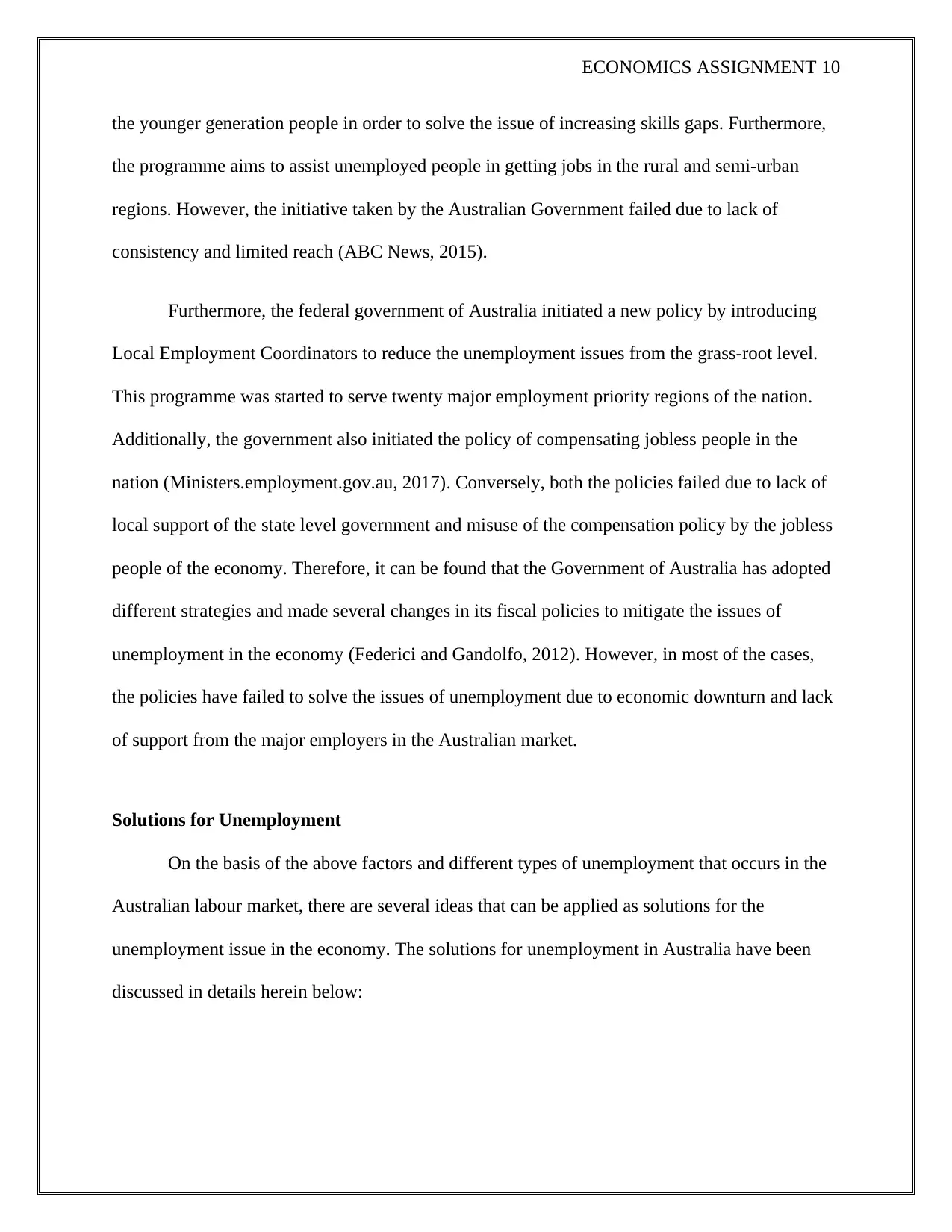
ECONOMICS ASSIGNMENT 10
the younger generation people in order to solve the issue of increasing skills gaps. Furthermore,
the programme aims to assist unemployed people in getting jobs in the rural and semi-urban
regions. However, the initiative taken by the Australian Government failed due to lack of
consistency and limited reach (ABC News, 2015).
Furthermore, the federal government of Australia initiated a new policy by introducing
Local Employment Coordinators to reduce the unemployment issues from the grass-root level.
This programme was started to serve twenty major employment priority regions of the nation.
Additionally, the government also initiated the policy of compensating jobless people in the
nation (Ministers.employment.gov.au, 2017). Conversely, both the policies failed due to lack of
local support of the state level government and misuse of the compensation policy by the jobless
people of the economy. Therefore, it can be found that the Government of Australia has adopted
different strategies and made several changes in its fiscal policies to mitigate the issues of
unemployment in the economy (Federici and Gandolfo, 2012). However, in most of the cases,
the policies have failed to solve the issues of unemployment due to economic downturn and lack
of support from the major employers in the Australian market.
Solutions for Unemployment
On the basis of the above factors and different types of unemployment that occurs in the
Australian labour market, there are several ideas that can be applied as solutions for the
unemployment issue in the economy. The solutions for unemployment in Australia have been
discussed in details herein below:
the younger generation people in order to solve the issue of increasing skills gaps. Furthermore,
the programme aims to assist unemployed people in getting jobs in the rural and semi-urban
regions. However, the initiative taken by the Australian Government failed due to lack of
consistency and limited reach (ABC News, 2015).
Furthermore, the federal government of Australia initiated a new policy by introducing
Local Employment Coordinators to reduce the unemployment issues from the grass-root level.
This programme was started to serve twenty major employment priority regions of the nation.
Additionally, the government also initiated the policy of compensating jobless people in the
nation (Ministers.employment.gov.au, 2017). Conversely, both the policies failed due to lack of
local support of the state level government and misuse of the compensation policy by the jobless
people of the economy. Therefore, it can be found that the Government of Australia has adopted
different strategies and made several changes in its fiscal policies to mitigate the issues of
unemployment in the economy (Federici and Gandolfo, 2012). However, in most of the cases,
the policies have failed to solve the issues of unemployment due to economic downturn and lack
of support from the major employers in the Australian market.
Solutions for Unemployment
On the basis of the above factors and different types of unemployment that occurs in the
Australian labour market, there are several ideas that can be applied as solutions for the
unemployment issue in the economy. The solutions for unemployment in Australia have been
discussed in details herein below:
Paraphrase This Document
Need a fresh take? Get an instant paraphrase of this document with our AI Paraphraser
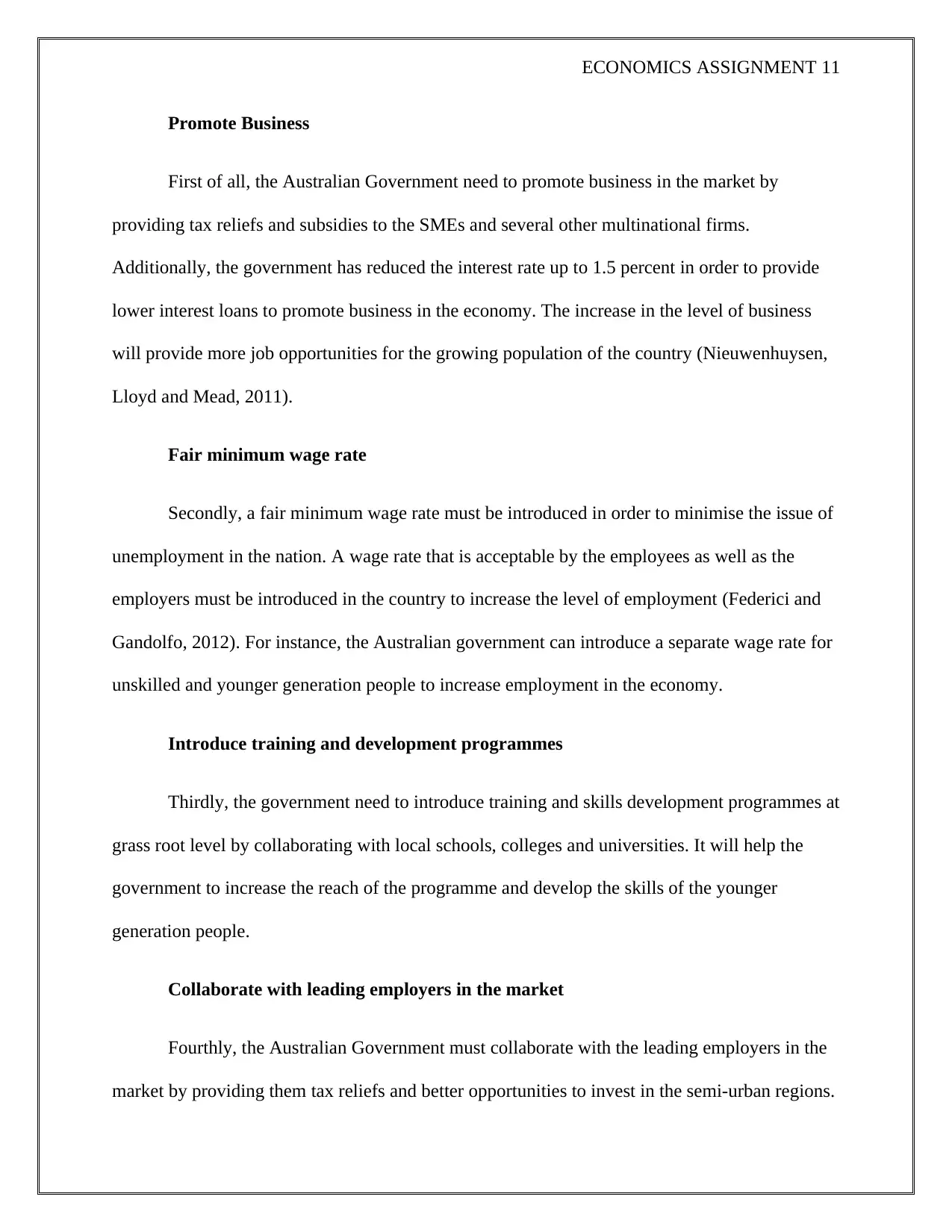
ECONOMICS ASSIGNMENT 11
Promote Business
First of all, the Australian Government need to promote business in the market by
providing tax reliefs and subsidies to the SMEs and several other multinational firms.
Additionally, the government has reduced the interest rate up to 1.5 percent in order to provide
lower interest loans to promote business in the economy. The increase in the level of business
will provide more job opportunities for the growing population of the country (Nieuwenhuysen,
Lloyd and Mead, 2011).
Fair minimum wage rate
Secondly, a fair minimum wage rate must be introduced in order to minimise the issue of
unemployment in the nation. A wage rate that is acceptable by the employees as well as the
employers must be introduced in the country to increase the level of employment (Federici and
Gandolfo, 2012). For instance, the Australian government can introduce a separate wage rate for
unskilled and younger generation people to increase employment in the economy.
Introduce training and development programmes
Thirdly, the government need to introduce training and skills development programmes at
grass root level by collaborating with local schools, colleges and universities. It will help the
government to increase the reach of the programme and develop the skills of the younger
generation people.
Collaborate with leading employers in the market
Fourthly, the Australian Government must collaborate with the leading employers in the
market by providing them tax reliefs and better opportunities to invest in the semi-urban regions.
Promote Business
First of all, the Australian Government need to promote business in the market by
providing tax reliefs and subsidies to the SMEs and several other multinational firms.
Additionally, the government has reduced the interest rate up to 1.5 percent in order to provide
lower interest loans to promote business in the economy. The increase in the level of business
will provide more job opportunities for the growing population of the country (Nieuwenhuysen,
Lloyd and Mead, 2011).
Fair minimum wage rate
Secondly, a fair minimum wage rate must be introduced in order to minimise the issue of
unemployment in the nation. A wage rate that is acceptable by the employees as well as the
employers must be introduced in the country to increase the level of employment (Federici and
Gandolfo, 2012). For instance, the Australian government can introduce a separate wage rate for
unskilled and younger generation people to increase employment in the economy.
Introduce training and development programmes
Thirdly, the government need to introduce training and skills development programmes at
grass root level by collaborating with local schools, colleges and universities. It will help the
government to increase the reach of the programme and develop the skills of the younger
generation people.
Collaborate with leading employers in the market
Fourthly, the Australian Government must collaborate with the leading employers in the
market by providing them tax reliefs and better opportunities to invest in the semi-urban regions.
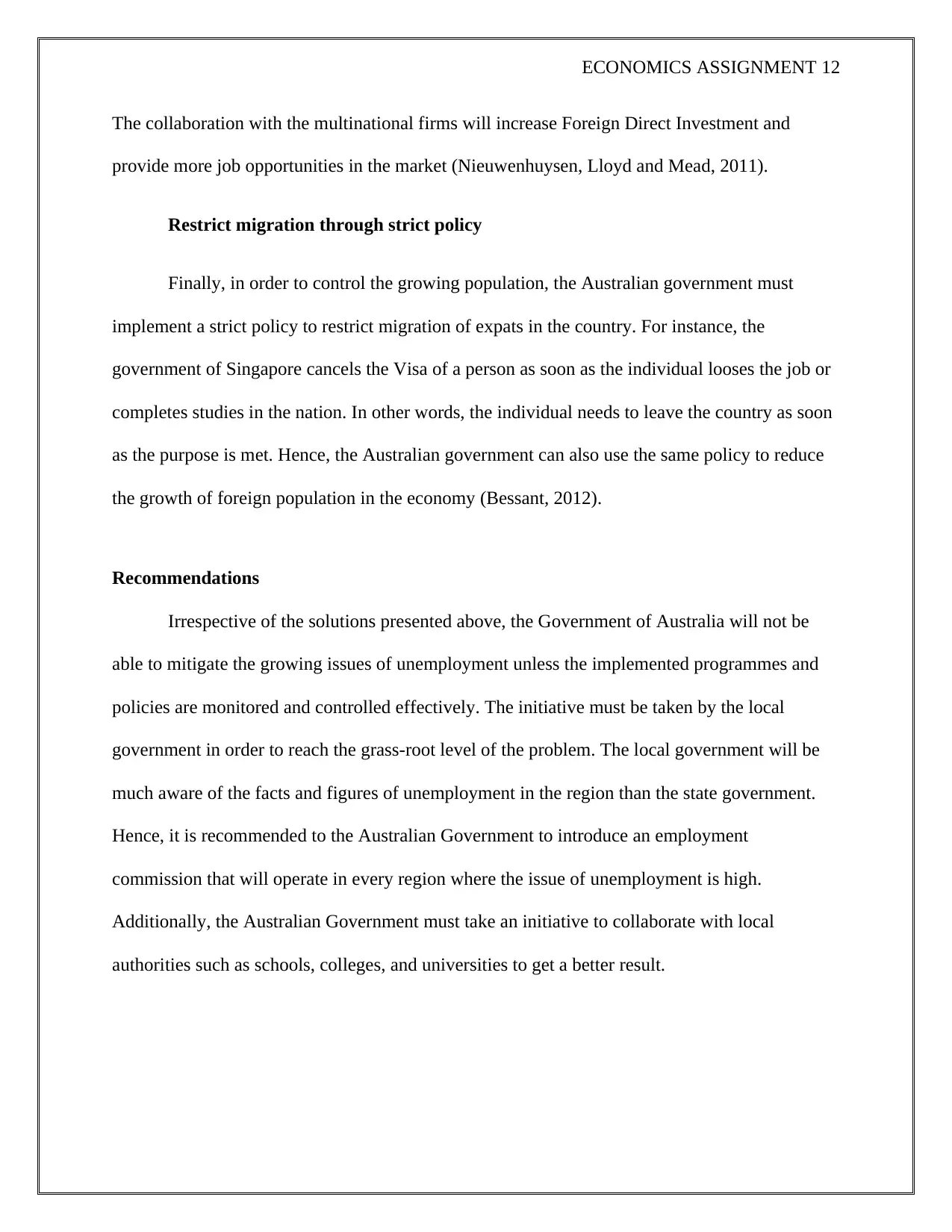
ECONOMICS ASSIGNMENT 12
The collaboration with the multinational firms will increase Foreign Direct Investment and
provide more job opportunities in the market (Nieuwenhuysen, Lloyd and Mead, 2011).
Restrict migration through strict policy
Finally, in order to control the growing population, the Australian government must
implement a strict policy to restrict migration of expats in the country. For instance, the
government of Singapore cancels the Visa of a person as soon as the individual looses the job or
completes studies in the nation. In other words, the individual needs to leave the country as soon
as the purpose is met. Hence, the Australian government can also use the same policy to reduce
the growth of foreign population in the economy (Bessant, 2012).
Recommendations
Irrespective of the solutions presented above, the Government of Australia will not be
able to mitigate the growing issues of unemployment unless the implemented programmes and
policies are monitored and controlled effectively. The initiative must be taken by the local
government in order to reach the grass-root level of the problem. The local government will be
much aware of the facts and figures of unemployment in the region than the state government.
Hence, it is recommended to the Australian Government to introduce an employment
commission that will operate in every region where the issue of unemployment is high.
Additionally, the Australian Government must take an initiative to collaborate with local
authorities such as schools, colleges, and universities to get a better result.
The collaboration with the multinational firms will increase Foreign Direct Investment and
provide more job opportunities in the market (Nieuwenhuysen, Lloyd and Mead, 2011).
Restrict migration through strict policy
Finally, in order to control the growing population, the Australian government must
implement a strict policy to restrict migration of expats in the country. For instance, the
government of Singapore cancels the Visa of a person as soon as the individual looses the job or
completes studies in the nation. In other words, the individual needs to leave the country as soon
as the purpose is met. Hence, the Australian government can also use the same policy to reduce
the growth of foreign population in the economy (Bessant, 2012).
Recommendations
Irrespective of the solutions presented above, the Government of Australia will not be
able to mitigate the growing issues of unemployment unless the implemented programmes and
policies are monitored and controlled effectively. The initiative must be taken by the local
government in order to reach the grass-root level of the problem. The local government will be
much aware of the facts and figures of unemployment in the region than the state government.
Hence, it is recommended to the Australian Government to introduce an employment
commission that will operate in every region where the issue of unemployment is high.
Additionally, the Australian Government must take an initiative to collaborate with local
authorities such as schools, colleges, and universities to get a better result.
⊘ This is a preview!⊘
Do you want full access?
Subscribe today to unlock all pages.

Trusted by 1+ million students worldwide
1 out of 16
Related Documents
Your All-in-One AI-Powered Toolkit for Academic Success.
+13062052269
info@desklib.com
Available 24*7 on WhatsApp / Email
![[object Object]](/_next/static/media/star-bottom.7253800d.svg)
Unlock your academic potential
Copyright © 2020–2025 A2Z Services. All Rights Reserved. Developed and managed by ZUCOL.




